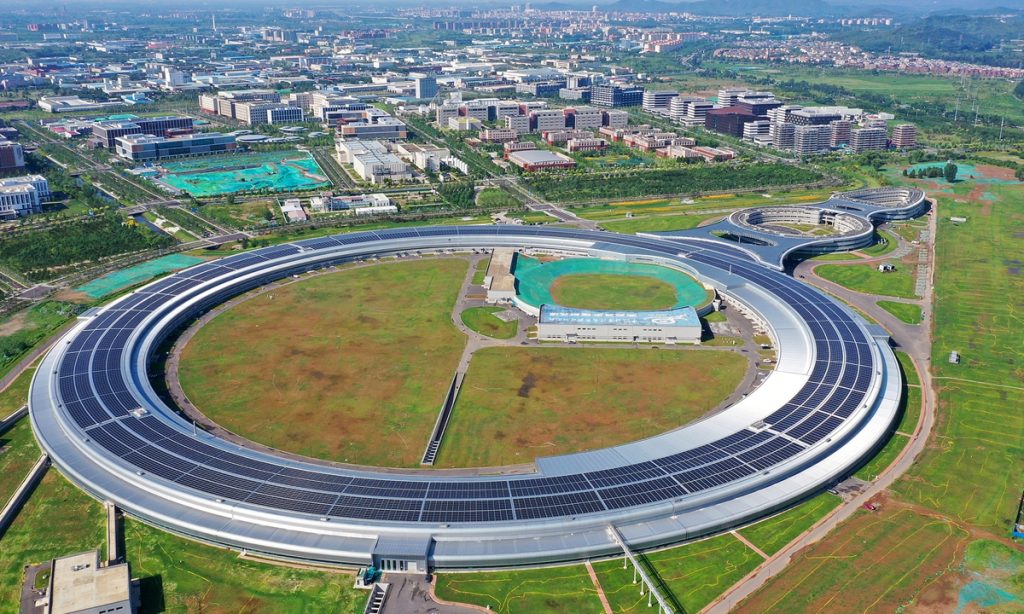China’s flagship synchrotron radiation facility expected to be operational by end of 2025: project director

China and Spain reached a cooperative agreement on April 11 in the field of synchrotron radiation light sources to promote the research and development of fourth-generation synchrotron radiation light source technologies and facilitate the open sharing of international large scientific facilities, the Xinhua News Agency reported.
The agreement was signed by the Institute of High Energy Physics (IHEP) under the Chinese Academy of Sciences, and the Consortium for the Construction, Equipping and Exploitation of the Synchrotron Light Source. It is part of the Action Plan for Strengthening the Comprehensive Strategic Partnership between the People's Republic of China and the Kingdom of Spain (2025-2028) as China has vowed to develop the comprehensive strategic partnership with Spain with greater strategic focus and vitality, according to Xinhua.
A synchrotron radiation light source is a source of electromagnetic radiation usually produced by a storage ring.
China is currently building its first high-energy synchrotron radiation light source, the High Energy Photon Source (HEPS). As one of the country's key scientific and technological infrastructure projects, HEPS is expected to become a fourth-generation synchrotron radiation facility with the world's highest brightness and will serve as a research platform for material science, chemical engineering, biomedicine and other fields.
The Global Times learned from IHEP that, by January, HEPS had achieved a world-class electron beam emittance of 93 picometer radians in the storage ring following the achievement of a beam current of more than 40 milliamps, which means that the HEPS accelerator construction is successful.
In late March, HEPS officially launched its joint commissioning phase, marking its final construction stage.
During the joint commissioning phase, multiple beamlines at HEPS are commissioned with the accelerator and perform specialized sample experiments aimed at further optimizing relevant indicators of the accelerator and beamlines, Pan Weimin, director of the HEPS project, told the Global Times.
According to Pan, the HEPS project is expected to complete acceptance and be operational by the end of 2025. When design values are reached, it will be able to emit light that is one trillion times brighter than the sun and will be open to users in fields such as aerospace, energy, environment, life science and pharmaceuticals.
HEPS can provide high-quality light for both domestic and international scientists in these fields, helping them analyze and explore the microscopic structure and evolution mechanisms of materials, covering a wide range of application scenarios. For instance, HEPS can be used for precision testing and lifecycle monitoring of certain materials like titanium alloys; it can be applied to observe how substances change and react during the generation and synthesis of new materials; and it can also be used to observe the scale of nanoparticles, thereby adjusting and enhancing the performance of nanomaterials, according to Pan.
Taking the application of HEPS in life sciences as an example, with the help of the first-generation light source, scientists discovered the molecular structure of the SARS virus. Now, with the construction of this fourth-generation light source, scientists will be able to observe virus more clearly, meticulously, and quickly, according to IHEP.
Construction of HEPS began in June 2019. From an aerial view, the HEPS, located in the Huairou Science City in Beijing, consists of three main buildings, with an overall shape resembling a magnifying glass, symbolizing a tool for exploring the microscopic world.
Experiences and innovative technologies utilized during the construction of HEPS could also pave the way for subsequent light source construction in China, according to Pan. For example, the HEPS construction team innovated a scheme to utilize its booster as both an accelerator and an accumulator, significantly reducing the infrastructure's costs.
These experiences and technologies can be applied to the construction of other large scientific facilities in China, helping future projects to save time and effort, Pan noted.